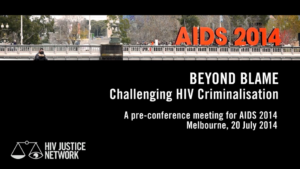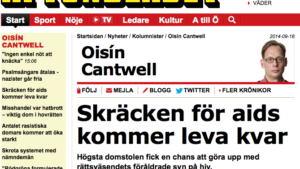Overview
Despite not having an HIV-specific law, Sweden has prosecuted more than 60 people living with HIV since 1987 using a range of laws contained in the Criminal Code, including causing danger to another, causing disease to another (aggravated), attempted aggravated assault, and aggravated assault. Sweden’s Communicable Disease Act also mandates disclosure of HIV-positive status before any kind of sex, although this has been modified recently to preclude people on effective treatment.
Prior to 2002, Sweden also had a history of forcibly isolating (approximately 80) people under the Communicable Diseases Act as ‘a preventative measure’. (See this important case decided by the European Court of Human Rights – Enhorn v Sweden [2005] E.C.H.R. 56529/00).
A 2004 ruling by the Supreme Court (B4189-03 (NJA 2004: 20) established a baseline for use of the criminal law, finding that not using a condom should always be regarded as an unacceptable risk. However, sustained advocacy by community-based organisations has slowly improved the legal approach to HIV in Sweden over the last decade.
In October 2013, the Public Health Agency and the Swedish Reference Group for Antiviral Therapy published a position paper on “Risk of HIV Transmission from patients on antiviral therapy”, summarising the latest research. That paper, colloquially known as The Swedish Statement, outlined the minimal risk of transmission during vaginal or anal sex if a person is on effective antiretroviral therapy.
Immediately following the Swedish statement, a number of convictions were overturned on appeal (e.g. October 2013 and November 2014), as courts found there had not been a risk of transmission. And a 2018 analysis of cases (2013-17) found court rulings after 2012 have resulted in milder verdicts, with a smaller proportion of defendants detained or deported.
However, Swedish prosecutors continued to pursue criminal cases. For example, in 2014 prosecutors had charged a man taking effective treatment with endangering others after he had condomless sex with a woman on two occasions. Both the district and appeal courts dismissed the matter, with the case appealed to the Supreme Court. Prosecutors claimed that the gross negligence of the man had exposed the victim to the danger of a serious illness: ‘a real danger’ as required by Swedish criminal law. In 2018, the Supreme Court delivered an important ruling dismissing the case and finding there was no concrete danger of transmission of infection as required by the Penal Code when an HIV-positive person on effective treatment has condomless sexual intercourse.
Consequently, HIV disclosure is no longer required before condomless sex if a person is on effective treatment. In 2020, Parliament voted to abolish this requirement in the Communicable Disease Act.
Nevertheless, cases can still be prosecuted. In a recent case from 2019, a man was prosecuted after having condomless sex with a woman (numerous times) without disclosing his HIV status. HIV was not transmitted. The court heard that the accused had not taken treatment regularly or used a condom. Prosecutors had wanted the man sentenced for ‘attempted cruelty’, but the district court convicted him of inducing danger to another, and sentenced him to one year in prison.
Laws
Swedish Criminal Code 1962:700
Chapter 3. On Crimes against Life and Health
Section 5. Anyone who inflicts another person’s bodily injury, illness or pain or puts him or her in disrepute or any other such condition shall be sentenced to assault for imprisonment for a maximum of two years or, if the offense is minor, to a fine or imprisonment for a maximum of six months.
Section 6. Is a crime referred to in Section 5 to be regarded as serious, sentenced to gross abuse to prison for a minimum of one year and six months and a maximum of six years. When assessing whether the offense is serious, special consideration must be given to whether the offense was fatal or whether the perpetrator has inflicted severe bodily injury or serious illness or otherwise showed special recklessness or cruelty.
If the crime is to be regarded as extremely serious, sentenced to extremely serious abuse to prison for a minimum of five and a maximum of ten years. When assessing whether the offense is extremely serious, particular consideration should be given to whether the bodily injury is permanent or whether the offense has caused extreme suffering or if the perpetrator has shown extreme recklessness.
Section 8. Anyone who negligently causes another person such bodily injury or illness which is not minor, shall be convicted of causing bodily harm or illness to a fine or imprisonment for a maximum of six months.
If the crime is serious, sentenced to imprisonment for a maximum of four years. When assessing whether the offense is serious, special consideration should be given to:
- if the offense has involved a deliberate risk-taking of a serious nature, or
- if the perpetrator, when special attention or skill was required, has been affected by alcohol or other means or otherwise done guilty of a serious misdemeanor.
Section 9. If any person of gross negligence exposes another to life or danger of serious bodily injury or serious illness, is convicted of causing danger to another to a fine or imprisonment for a maximum of two years.
Chapter 23. On Attempt, Preparation, Conspiracy and Complicity
Section 1. A person who has begun to commit a crime without bringing it to completion, shall, in cases where specific provisions exist for the purpose, be sentenced for attempt to commit crime if there was a danger that the act would lead to the completion of the crime or such danger had been precluded only because of fortuitous circumstances. Punishment for attempt shall be at most what is applicable to a completed crime not less than imprisonment if the least punishment for the completed crime is imprisonment for two years or more.
Communicable Disease Act 2, Chapter 2
Section 2
He or she who knows that they carry a dangerous public health disease is required to provide information about the infection to other people that he or she will be in contact with such that a considerable risk of transmission may arise.
Note: The obligations that the HIV-positive individual has to their sex partners can be found in the rules of conduct given by the attending physician who notifies the person that he or she is HIV-positive.
Further resources
Brochure, published by HIV Nordic, highlighting key questions on HIV transmission and exposure criminalization for people living with HIV in Denmark, Sweden, Norway, Finland and Iceland.
The study assesses the effect of the new recommendations from the Public Health Agency of Sweden on court rulings after 2012 as well as the factors which influence verdicts overall.
Acknowledgements
Our thanks to Sweden’s RFSU (Swedish Association for Sexuality) and the Australian law firm Hall & Wilcox for their research assistance to confirm current relevant legislation.
HIV Justice Network's Positive Destinations
Visit the Sweden page on Positive Destinations for information on regulations that restrict entry, stay, and residency based on HIV-positive status, as well as access to HIV treatment for non-nationals.











